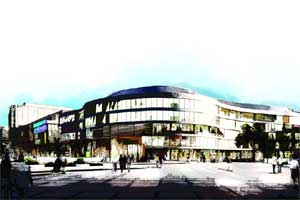Long unending queues to enter multi-level parkings, exceeding footfalls on the elevators and more than a dozen washrooms showing ‘busy’ signs. Yes, shopping malls have brought in a new culture of shopping in India. Traditional shopping in scorching heat has given way to a more sophisticated AC (read mall) shopping not only in metros but Tier-2 and Tier-3 cities. Kiranawalas have been fighting all but a losing battle post an onslaught of big brands willing to sell more at a lesser price.
However, despite the glitz and glamour associated with ‘mall hopping’ and ‘mall shopping’, the big question remains as to whether all malls in India are profitable?
A recent report by JLL India ‘‘Is Indian Real Estate Heading Towards A Tectonic Shift?’ said that the divide between successful and unsuccessful malls in India is widening.
“The difference in the overall vacancy rate between successful and unsuccessful malls stands at more than 10% across major Indian cities. Around 14 malls, having a combined mall space of 3.5-4.5 million sq ft, are expected to withdraw from retail operations in the near future,” the report said.
According to JLL India, there are around 260 malls of Grade A quality (excluding shopping centres that operate on strata-sold model) that exist across India. Among these, merely 70-odd malls are ones we can call successful, based on their vacancy levels, rental value (RV) appreciation and tenants profile. These are malls that have vacancy of not more than 10-12%, have seen reasonable growth in RV, and host anchor tenants and popular brands that are crowd pullers. However, close to 100 malls operate unsuccessfully owing to high vacancy, limited footfalls, slow RV growth and poor tenants profile. These are malls that have vacancy upwards of 18-20%, have given negligible rental growth and have limited presence of popular brands.
For some malls, even the design and construction quality is poor. The remaining malls lie somewhere in between good performing and bad performing malls – average performers.
The report said developers who had resorted to break-neck pace of construction of malls in response to a rise in organised retail business have now reduced supply of mall space in India due to rising vacancy levels.
The malls are lacking in management, a key ingredient for a mall to become successful. As tenants are not stable like commercial buildings, an intelligent mall management involves planning the right tenant mix, space optimisation and zoning and constantly studying shopper behaviour. They need to tap the shoppers feedback for all seasons apart from catering to various brand categories.
According to Santosh Yellapu, analyst, Angel Broking, “The gap between successful and unsuccessful malls is widening.”
He believes that many developers entered the mall business without any experience, visibility or any defined processes.
“They didn’t position themselves properly nor did they adopt to the emerging atmosphere. The mall developers make huge investment and over the period of 10-30 years they get the annuity streams assuming that 80% of mall is occupied, but many of these developers invested huge but they never focused on identifying areas by which they can monetise”, he says.
Also, most of the non-profitable malls have been fairly negligible in following emerging trends in brands and new products.
They entered into longer agreements with outdated retailers and went for quantity rather than quality. The JLL report also states, “Some malls perform poorly as they are unable to define the mall type, lack research on catchment and selection of wrong partners. By turn of the current decade, it was evident that mall management was not in the genes of every developer.”
The overall vacancy rate today stands high at ~20% in retail malls across major Indian cities. On the contrary, malls that run successfully have vacancies of not more than 10%, with a selective few ones operating near full capacities.
In recent years, the not so good managed malls have succumbed to the business viability stress and giving up hope. Consequently, these malls are either converting into Grade-B office spaces or getting demolished to make way for a new asset class in real estate.
Santosh Yellapu says that mall management is only meant for specialised mall developers.
However, he feels that coming times will witness the surviving and profitable malls charging more premium for their sustainable value.
In the near future, more malls will withdraw from the retail realty business as a result of which, the business of average and good performing malls will improve. This is a much-needed course correction, which will continue to happen for some time.
If recent reports are to be believed then around 14 malls with a combined space of roughly 4 million sq ft are expected to withdraw from retail operations soon.

